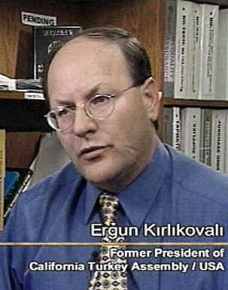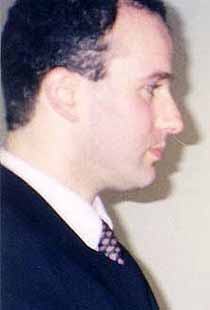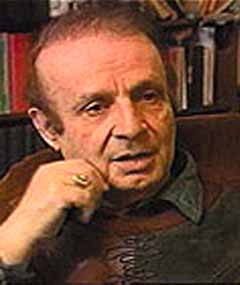|
|
Vahakn Dadrian did not like an article by Guenter
Lewy, entitled "Revisiting the Armenian Genocide," and appearing in The
Middle East Quarterly. Dadrian then put his one-sided scholarship to the
test by soliciting an Islamophobic web site, Jihad Watch, to
exclusively showcase his response in.
You can read more about that in:
Vahakn
Dadrian Objects to Guenter Lewy
But Dadrian did not stop there. He penned an
abbreviated version of his objections, for inclusion in the letters page of
the publication. That, along with two other letters, may be seen below. See
how Prof. Guenter Lewy reacts to the prosecuting professor, who will
deceptively say anything and everything to affirm his precious genocide.
|
|
|
| Revisiting
the Armenian Genocide |
To the Editor:
I must express my delight at reading Guenter Lewy's balanced treatment of the
Turkish-Armenian conflict ("Revisiting the Armenian Genocide," Fall 2005) in the
pages of the Middle East Quarterly. I have the utmost admiration and respect for the
honesty and truthfulness displayed in the article.
 |
|
Ergun
Kirlikovali |
I am one of the eight children of a much ignored and
dismissed Balkan-Turkish genocide victim. My father, as a one year-old baby, somehow
escaped the horrors of the Balkan wars (1911-13) but without any parents, relations, or
even neighbors or acquaintances. All vanished from the face of this earth without a trace.
To this day, we don't know where my father's family is buried although we suspect
somewhere near the village of Kirlikova, which today sits in northern Greece. In 1912, he
was thrown along with thousands of other orphaned Turkish babies into one of the last
trains departing from Selanik (Thessaloniki today) to the Ottoman capital of Istanbul. The
Ottoman state cared for him until 1923 when the newly-established Turkish republic took
over. He graduated from the University of Istanbul in 1939 and served as a forestry
engineer for thirty-four years before passing away in 1973.
There are millions of Turks today who have similar stories. Those Turkish refugees who
survived massacres in the Balkans, the Aegean Islands, the Crimea, the Caucasus, and
elsewhere met another cycle of Christian violence in Anatolia at the hands of Greeks in
the West and Armenians in the East. Our stories have not been told because of endless
Armenian propaganda, which, since 1915, has saturated the West. My pain was never shared.
My tears went unnoticed. Lewy's essay stirred such deep emotions in me, and a sense of
fairness emanating from it soothed my even deeper wound.
Ergun Kirlikovali
Santa Ana, California
To the Editor:
The scholarship behind Guenter Lewy's article, "Revisiting the Armenian
Genocide" (Fall 2005), was unimpressive. He is wrong to state that "many
historians
in the West" deny the Armenian genocide. Quite the contrary, very few
do.
 |
|
Nicolas
Tavitian |
Professor Lewy's methodology is weak. He reduces evidence
concerning the genocide to documents regarding the 1919-20 trials, the "Special
Organization," and to the Memoirs of Naim Bey. The evidence of genocide, however, is
far more extensive. The genocide was carried out in its most intensive phase for over a
year in full view of Turks, Armenians, Kurds, as well as foreign missionaries, diplomats,
and military officials. Archives, memoirs, eyewitness accounts, and newspaper reports all
show a systematic and deliberate elimination of the Armenian population.
Lewy limits his argument to what he says did not happen. He does not address what did
occur. If the killings were simply the actions of "Kurdish tribesmen and corrupt
policemen," then these rogue elements eradicated a population from the Ottoman Empire
that had weathered 2,500 years of conquests and invasions. Genocides usually fail. There
are Jews in Germany today, and Tutsis in Rwanda. But, Istanbul aside, there are no
Armenians in Turkey. What happened, if not genocide?
The question of the Armenian genocide remains a serious issue for Turkey's relations with
both Europeans and Americans. Western nations hold a cooler and more open approach to
history, in which recognition of past crimes is a necessary step toward friendly and
cooperative relations. Turkey has not reached a stage where it is willing to recognize its
past atrocities. This is why Turkey's denial of the Armenian genocide threatens to become
a major impediment to Turkey's accession into the European Union.
Nicolas Tavitian
Director of European Programs
Armenian General Benevolent Union
|
Vahakn
Dadrian's Piece of Mind
|
To the Editor:
Guenter Lewy's article contains errors that undercut his thesis: the Turkish
courts-martial were in Istanbul, not Yozgat; Mehmet Kemal was Kaymakam only of
Bogazliyan and not of Yozgat; Cemal Pasha was commander of the Fourth Army, not the
governor of Aleppo; Liparit was an Armenian activist, not a German missionary; Malta
was not a venue for criminal trials but a temporary detention center.
While Lewy relies on two Turkish authors who dismissed the Naim-Andonian documents
as forgeries, a subsequent German researcher visited the Ottoman state archives and
established that the state documents "confirm to some degree the contents of
two other" Naim-Andonian documents.[1] Moreover, Lewy ignored my extensive
analysis of these disputed documents.[2]
 |
|
Vahakn
Dadrian |
Lewy misinterprets evidence with which he
attempted to construct his revisionist account. He took issue with the military
tribunal's key indictment to which the court appended forty-two authenticated
documents. But he misunderstands the facts of the Ottoman criminal justice system.
It was an inquisitorial system, modeled after its French counterpart. For proof of
guilt, judges balance evidence with defense counter-arguments. Such evidence
consists of confessions, witness and expert testimony, official records, discovery,
judicial notice, searches and seizure.[3] Several dozen Turkish witnesses, including
two army commanders, several other high-ranking military officers, physicians, and
governors testified. The ensuing verdicts confirmed the premeditation of the
Armenians' mass murder.
Lewy is incorrect about General Vehip. His written testimony is recorded and extant
in several sources, including period newspapers.[4] Lewy's reliance on the three
high commissionersone American and two Britishis misplaced because each
denounced the military tribunal for its "failure" to exact justice
commensurate with the gravity of the crime committed against the Armenians. As U.S.
high commissioner Lewis Heck stated, "The great majority of the Turkish
officials in the interior either actively participated in, or at least condoned the
massacres of the Armenians."[5] On another occasion, he declared "the
great majority of the Turkish race heartily approved of these massacres."[6]
The loss of the military tribunal's documents, which Lewy uses to undercut reliance
on the documents, coincides with the Kemalist seizure of Istanbul in 1922.
Lastly, Lewy's discussion of the Special Organization, the main instrument of
Armenian massacres, is marked by error. The German Colonel Stange was, according to
both authentic Austro-Hungarian and Ottoman sources, commander of a Special
Organization regiment otherwise identified as The Detachment. Its several units,
consisting of released convicts, participated in the massacres against Armenians.
After acknowledging them as chettes (bandits), Stange, denounced them as "scums."[7]
Lewy mistranslates the autobiographical account of Esref Kusçubasi, that
organization's principal leader. Lewy denies that the convicts enrolled in that
organization "took the lead role in the massacres." But, Kusçubasi
bragged that he "performed secretly charted duties" in conducting the
Armenian deportations.[8] In contrast to Lewy's arguments, the historical evidence
is clear. Ottoman authorities conducted premeditated genocide against the Armenian
population.
Vahakn N. Dadrian
Director, Genocide Research, Zoryan Institute
Cambridge, Mass./Toronto, Can.
Academy of Sciences, Republic of Armenia
|
| Guenter
Lewy responds: |
Mr. Kirlikovali is correct that the tribulations of Turkish refugees from the Balkan wars
and other armed conflicts of the pre-World War I era have not received the attention and
condemnation they deserve. The West has been preoccupied with the horrors of the Armenian
story, and the suffering of Turks has often been ignored. The same holds true for the
wartime famines that took a heavy toll of life among both Turks and Armenians. This double
standard in recognizing human misery must be repudiated for the sake of historical truth
and to help descendants of these victims live with their pain.
In response to Mr. Tavitian: yes, a large number of Western students of Ottoman history
reject the appropriateness of the genocide label for the tragic fate of the Armenian
community in Ottoman Turkey. This list includes distinguished scholars such as Roderic
Davison, J.C. Hurewitz, Bernard Lewis, and Andrew Mango. Ignoring this formidable array of
learned opinion, most Armenians and their supporters among so-called genocide scholars
assert with superb arrogance that the Armenian genocide is an incontrovertible historical
fact, similar to the Jewish Holocaust, which would be denied only by lackeys of the
Turkish government. One pro-Armenian author, Henry C. Theriault, has even suggested that
denial of the Armenian genocide represents hate speech and, therefore, should be illegal
in the United States.
In a short article, it is impossible to put forth all of the evidence that contradicts the
notion of a premeditated plan of annihilation. I do so in my book on the Armenian
massacres,[9] on which my essay is based. The reports of American, German, and Austrian
consular officials as well as the accounts of Western missionaries, who were on the spot
in Anatolia, confirm the occurrence of large-scale killings but do not implicate the
"Special Organization" or any other agency of the central government. Mr.
Tavitian's allegation of "a systematic and deliberate elimination of the Armenian
population" is further undercut by the exemption of the large Armenian communities of
Istanbul, Izmir, and Aleppo from deportation. These exemptions are analogous to Hitler
exempting the Jews of Berlin, Frankfurt, and Cologne from the final solution.
I welcome Mr. Dadrian's close reading of my article, which indeed
caught a few minor factual errors. However, regarding the points of substance, Dadrian
again displays his skill in the use of selective evidence. For example, the alleged
thirty-one telegrams of Talât Pasha contained in the Naim-Andonian volume, some of which
order the killing of all Armenians, are rejected as crude forgeries not only by Turkish
historians but also by almost all Western students of Ottoman history. Hilmar Kaiser,
cited by Dadrian and the one exception to this rule, did say documents from the Ottoman
Ministry of the Interior "confirm to some degree" two telegrams, but he
concluded that "further research on the Naim-Andonian' documents is
necessary."
If Dadrian wants to consider the verdict of the Turkish courts-martial as proof of the
guilt of the Young Turk regime in the premeditated murder of Ottoman Armenians, he is, of
course, free to do so. However, his readers should know that the evidence relied upon by
the military tribunals"confessions, witness and expert testimony, official
records, discovery, judicial notice, searches and seizure"is of doubtful
reliability. Among other shortfalls in due process, it was never subject to
cross-examination. More importantly, this evidence does not actually exist. Wherever the
blame for this situation is to be placed, the fact is that all of the original
documentation of the trials is lost, and we have nothing but copies of some documents in
the gazette of the Ottoman government and the press. It is doubtful that the Nuremberg
trials would ever have attained their significance in documenting Nazi crimes had only
unauthenticated copies of documents existed.
I know of no authentic sources that prove Stange's service as a commander of a Special
Organization unit engaged in the massacre of Armenians. It is in Dadrian's gloss and not
in the original documents that Stange confirms the transfer of brigands employed in
guerilla war to mass murder duties, and it is Dadrian, not Stange, who equates the
"scum" involved in massacre with released convicts and enrolls them into the
ranks of the Special Organization. Similarly, the leading Special Organization official,
Esref Kusçubasi, after his capture indeed bragged about his exploits in secret
operations, but it is only through the shrewd juxtaposition of words taken from different
parts of the book in question and Dadrian's insertions that this account becomes an
acknowledgment of involvement with the Armenian deportations.
Hilmar Kaiser, on whom Dadrian relies for his defense, has drawn attention to
"misleading quotations" and the "selective use of sources" in
Dadrian's work, and he has concluded that "serious scholars should be cautioned
against accepting all of Dadrian's statements at face value."[10] I concur in this
judgment.
|
Footnotes
|
[1] Hilmar Kaiser, "The Baghdad Railway and the Armenian Genocide,
1915-1916," in Richard G. Hovannisian, ed. Remembrance and Denial: The Case of
the Armenian Genocide (Wayne State University Press, 1999), p. 109.
[2] Vahakn N. Dadrian, "The Naim-Andonian Documents on the World War I
Destruction of Ottoman Armenians: The Anatomy of a Genocide," International
Journal of Middle Eastern Studies, Aug. 1986, pp. 311-60.
[3] Articles 130, 214, 222, 232, 233, "Ottoman Criminal Code of
Procedures," in George Young, Corps de Droit Ottoman, v. VII (Oxford: Clarendon
Press, 1905).
[4] Vakit, Mar. 31, 1919; Hayat Tarih Mecmuasi, vol. 11, no. 3, Nov. 1981; Le
Courrier de Turquie (Turkish Association for the Defense of the Fatherland), Apr. 1,
2, 1919.
[5] U.S. National Archives, R.G. 256, 867.4016/2, pp. 2, 3.
[6] Ibid.; idem, 867.00/59, p. 3.
[7] Haus-, Hof- und Staatsarchiv (HHSTA), Vienna, PAI 942, Krieg 21a Türkei; Altay
Yigit, Karadeniz Muharebeleri (Trabzon: Istikbal, 1950), p. 351.
[8] Cemal Kutay, Birinci Dünya Harbinde Teskilâte Mahsusa (Istanbul: Ercan, 1962),
p. 78.
[9] The Armenian Massacres in Ottoman Turkey: A Disputed Genocide (Salt Lake City:
University of Utah Press, 2005).
[10] Hilmar Kaiser, "Germany and the Armenian Genocide, Part II: Reply to
Vahakn N. Dadrian's Response," Journal of the Society for Armenian Studies, 9
(1996): 139-40.
Holdwater: Regarding Dadrian's complaint, "Lewy
ignored my extensive analysis of these disputed documents.[2]," what Lewy has
done is chosen to exclude what is perhaps Dadrian's greatest embarrassment
(pathetically trying to validate what are so obviiously forgeries) only in Lewy's article. Lewy analyzed Dadrian's 1986
exercise in pure propaganda, in Lewy's book, mainly p. 69, where we are told Dadrian
dismissed the discrepancies as mere "technicalities" (!), and Lewy
notes Dadrian himself does not refer to Andonian's work (History of the Armenian
Genocide and Warrant for Genocide), "and does not even list
Andonian's work in the bibliographies of these books." (The comprehensiveness
of Prof. Lewy's book is remarkable, having fairly examined the voluminous sources
from both sides of the table... what we have here is genuine scholarship.) Isn't it
telling, ladies and gentlemen, that even this master propagandist, Vahakn Dadrian,
avoids Andonian, while feeling no compunction in throwing everything else of a
dubious nature he thinks he can get away with? Dadrian can really belt out the Armenian AND? Anthem, we'll give
him that much.
|
| HEAR PROF. LEWY
embellish Dadrian's ethical shortcomings, from a February 2006 discussion
at the University of Utah. |
Further reading:
Guenter
Lewy responds to more genocide-advocating professionals
|
|